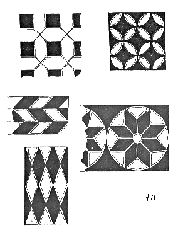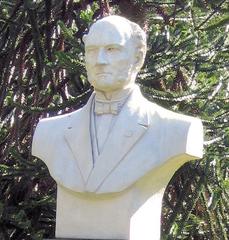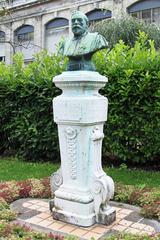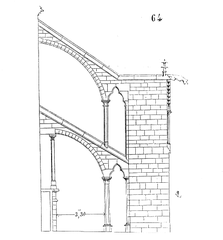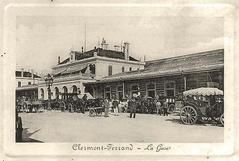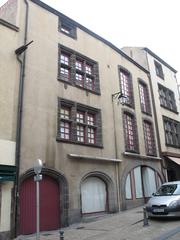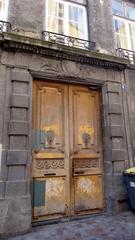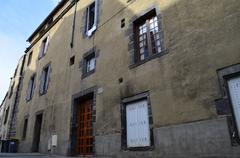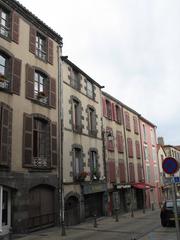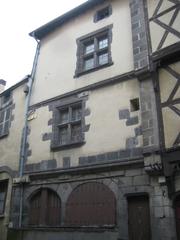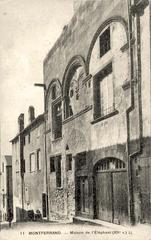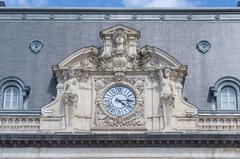Hôtel De Champflour Visiting Hours, Tickets, and Comprehensive Guide | Clermont-Ferrand Historical Sites
Date: 14/06/2025
Introduction
The Hôtel De Champflour stands as a remarkable emblem of Clermont-Ferrand’s aristocratic and architectural heritage. Situated in the heart of the city’s medieval center, this historic mansion showcases the evolution of French urban architecture, distinguished by its use of black volcanic stone and its layers of Renaissance, Baroque, and Enlightenment-era design. Although the mansion is privately owned and not routinely open for independent public visits, it remains a highlight on guided walking tours and during special cultural events—offering rare glimpses into its grand courtyard, elegant staircase, and intricately sculpted features. This comprehensive guide details everything you need to plan your visit, including practical information about visiting hours, ticketing, accessibility, and nearby attractions.
(Monumentum, Deep Heart of France, Kayra Tours)
Table of Contents
- Introduction
- Historical and Architectural Overview
- Cultural and Social Context
- Visitor Information
- What to See
- Nearby Attractions & Travel Tips
- Practical Information
- Seasonal and Budget Considerations
- Sustainable Tourism
- Frequently Asked Questions (FAQ)
- Conclusion
- Sources and Further Reading
Historical and Architectural Overview
Evolution and Significance
The Hôtel De Champflour’s origins trace back to the 16th century, with substantial modifications in the 17th and 18th centuries. Commissioned by the influential Champflour family—nobility of the Auvergne region—the mansion’s architecture chronicles the city’s transition from fortified medieval dwellings to the decorative styles of the Renaissance and Baroque eras. The building’s symmetrical façade, elaborate stonework, and imposing entrance are exemplars of French urban aristocratic design.
Constructed predominantly from Clermont-Ferrand’s signature black volcanic stone, the Hôtel reflects both the region’s geological uniqueness and its social stratification. Renaissance carved elements are integrated into later Baroque and Enlightenment additions, creating a palimpsest of architectural innovation. Notably, 18th-century renovations introduced modern amenities, such as running water via a canalization system from the Fontaine du Terrail—a rare luxury at the time (Monumentum).
Key Architectural Features
- Central Courtyard: The heart of the mansion, featuring arcaded galleries with semicircular arches, prominent keystones, and square pillars adorned with moldings.
- Grand Staircase: A three-flight (escalier tournant) staircase, dating from the 17th century, accessible through the arcaded gallery.
- Façades & Interior: 18th-century updates introduced larger windows, smoother stonework, and refined interior arrangements, reflecting Enlightenment ideals.
- Sculpted Details: Renaissance motifs and period woodwork remain visible throughout the property.
The Hôtel is listed as a Monument Historique, with its courtyard, staircase, and sculpted elements under official protection since 1989 (Monumentum).
Cultural and Social Context
Strategically located on rue Pascal (formerly rue des Nobles), the Hôtel was at the heart of Clermont-Ferrand’s aristocratic quarter. It served as a residence for the elite, a venue for influential gatherings, and a symbol of social status. Its advanced amenities—like running water—highlight the progressive nature of its owners.
During the upheaval of World War II, Clermont-Ferrand briefly became the provisional capital of France. While there is no direct evidence that Hôtel De Champflour was used for official government functions, its proximity to key buildings suggests it was central to the city’s wartime activities (Deep Heart of France).
Visitor Information
Visiting Hours
- Exterior Viewing: The façade and architectural details can be admired from the street year-round.
- Interior Access: The mansion is privately owned and not open for regular public visits. Interior access is occasionally granted during special cultural events, notably the annual European Heritage Days (Journées du Patrimoine) in September (Monumentum).
Tickets
- Street Viewing: No ticket is required to view the exterior.
- Special Events: Interior access during events is typically free or may require advance booking. Check with the Clermont-Ferrand Tourist Office for details.
Accessibility
- The historic center is pedestrian-friendly and accessible by public transport, including Tram A and several bus lines.
- The courtyard and ground floor are generally accessible during public events, but upper floors may not be suitable for those with reduced mobility due to preserved historic stairs.
- The Tourist Office provides accessibility resources, including audio guides and materials in multiple languages.
Guided Tours & Special Events
- Guided Walking Tours: The Hôtel De Champflour is featured in several historical walking tours, which provide expert commentary on its significance (Kayra Tours).
- Cultural Events: Occasional exhibitions and performances are hosted at the mansion. Check the city’s event calendar for current programming.
What to See
- Courtyard: The arcaded galleries and sculpted keystones offer excellent photo opportunities, especially in the early morning or late afternoon.
- Staircase: A highlight of 17th-century design, emblematic of French Baroque architecture.
- Façades & Stonework: Observe the blend of Renaissance motifs and the unique volcanic stone characteristic of Clermont-Ferrand.
Nearby Attractions & Travel Tips
- Cathédrale Notre-Dame-de-l’Assomption: An iconic Gothic cathedral built from the same volcanic stone.
- Place de Jaude: The city’s lively central square, filled with shops, cafés, and monuments.
- Notre-Dame-du-Port Basilica: A UNESCO World Heritage Romanesque church.
- Rue des Chaussettes: Known for artisanal boutiques and vibrant street art.
Wear comfortable shoes for cobblestone streets and consider combining your visit with a guided city tour for a richer experience.
Practical Information
- Location: 31 rue Pascal, 63000 Clermont-Ferrand, France
- Transport: Accessible via public transport, taxis, and by foot from the city center.
- Facilities: Public restrooms, cafés, and restaurants are available nearby.
- Language: French is primary, but English, German, and Spanish-speaking guides are available through the Tourist Office.
Seasonal and Budget Considerations
- Spring & Autumn: Mild weather, fewer crowds, and vibrant local events.
- Summer: Warm and lively, but peak tourist season—book tours and accommodation early.
- Winter: Cold with occasional snow, but festive markets and fewer visitors.
- Budget Tips:
- Visit in June or September for better rates and smaller crowds.
- The ClermontPass offers discounts on public transport and attractions.
- Eat at local bakeries for affordable regional specialties.
Sustainable Tourism
- Walk or use public transport to minimize your environmental impact.
- Support local businesses and artisans.
- Adhere to all site guidelines and respect the privacy of private properties.
Frequently Asked Questions (FAQ)
Q: Can I visit the interior of the Hôtel De Champflour?
A: Interior access is generally limited to special events such as European Heritage Days or select guided tours.
Q: Are there entrance fees?
A: No fees for exterior viewing; event access may be free or require booking.
Q: Is the site accessible for people with disabilities?
A: The historic center and ground floor are accessible; upper floors may not be. The Tourist Office provides detailed accessibility information.
Q: Where can I find guided tours?
A: Book through the Clermont-Ferrand Tourist Office or with providers such as Kayra Tours.
Q: What are the best months to visit?
A: May to September, especially during cultural festivals and heritage days.
Conclusion
The Hôtel De Champflour is a testament to Clermont-Ferrand’s architectural splendor and noble past. While public access is limited, special events and guided tours offer valuable opportunities to experience its unique heritage. Its central location makes it a perfect starting point for exploring the city’s other historical and cultural treasures. For the most up-to-date information, download the Audiala app, follow us on social media, and consult local tourism resources to maximize your visit.
Sources and Further Reading
- Monumentum: Hôtel de Champflour
- Deep Heart of France: Clermont-Ferrand Capital
- Kayra Tours: Free Guided Walking Tours Clermont-Ferrand
- Clermont-Ferrand Tourist Office
- Actuacity: Hôtel de Champflour
- Commons Wikimedia: Monuments historiques in Clermont-Ferrand
- Where and When: Clermont-Ferrand
- Switch Bridge Tours: Clermont-Ferrand Bike Tours
- Komoot: Attractions around Clermont-Ferrand
- France-Voyage.com: Clermont-Ferrand
- The Good Life France: Guide to Clermont-Ferrand
